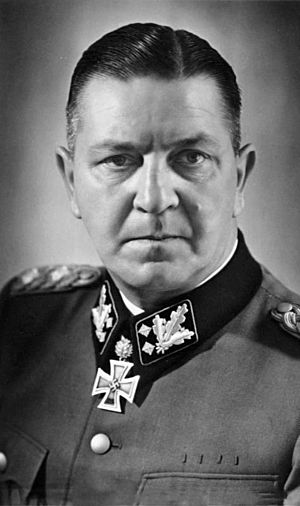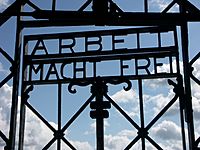Theodor Eicke facts for kids
Quick facts for kids
Theodor Eicke
|
|
|---|---|
 |
|
| Born | 17 October 1892 Hampont (Hudingen), Elsass-Lothringen, German Empire |
| Died | 26 February 1943 (aged 50) near Lozova, Ukrainian SSR, Soviet Union |
| Allegiance | |
| Service/ |
Bavarian Army |
| Years of service | 1909–19 (Bavaria) 1930–1943 (SS) |
| Rank | SS-Obergruppenführer |
| Service number | NSDAP #114,901 SS #2,921 |
| Unit | SS-Totenkopfverbände Waffen-SS |
| Commands held | Dachau concentration camp SS Division Totenkopf |
| Battles/wars | World War I
|
| Awards | Knight's Cross of the Iron Cross with Oak Leaves |
Theodor Eicke (born October 17, 1892 – died February 26, 1943) was a high-ranking officer in the SS during the time of Nazi Germany. He also led a division in the Waffen-SS. Eicke was very important in setting up and running the Nazi concentration camps.
He was the second leader of the Dachau concentration camp from June 1933 to July 1934. He helped carry out the killings of some leaders of the SA during an event called the Night of the Long Knives in 1934. Eicke continued to expand the concentration camp system. He became the first Inspector of Concentration Camps. In 1939, Eicke became the commander of the SS Division Totenkopf within the Waffen-SS. He led this division during World War II on both the Western and Eastern fronts. Eicke died on February 26, 1943. His plane was shot down during the Third Battle of Kharkov.
Contents
Early Life and World War I Service
Theodor Eicke was born on October 17, 1892. He was born in Hampont, a village that was then part of Germany. He was the youngest of 11 children in a family that was not wealthy. His father worked as a station master and was known as a German patriot.
Eicke did not do well in school and left at age 17 before finishing. In 1909, he joined the Bavarian Army as a volunteer. He served in different infantry regiments.
Eicke's Role in World War I
When World War I began in 1914, Eicke fought in the Lorraine campaign. He also took part in the First Battle of Ypres in 1914 and the Second Battle of Ypres in 1915. He was also at the Battle of Verdun in 1916. Eicke worked as a clerk and an assistant paymaster. He also served as an infantryman on the front lines. He received the Iron Cross Second Class for his bravery. However, he spent most of the war working behind the lines.
In late 1914, Eicke married Bertha Schwebel. They had two children, a daughter named Irma and a son named Hermann.
After the First World War
After World War I ended, Eicke continued to work as an army paymaster. He served in the Reichswehr of the Weimar Republic until 1919. Eicke then tried to study at a technical school but had to stop because he did not have enough money.
From 1920, Eicke worked as a police officer. He first worked as an informant and then as a regular policeman. His police career ended in 1923. This was because he openly disliked the Weimar Republic. He also took part in violent political protests. In 1923, he found work at IG Farben in Ludwigshafen am Rhein. He worked there as a "security officer" until 1932.
Joining the SS
Early SS Membership and Exile
Eicke shared the views of the Nazi Party. He joined the party on December 1, 1928. He also joined the Sturmabteilung (SA), which was the Nazi Party's street organization. Eicke left the SA in August 1930 to join the Schutzstaffel (SS). He quickly moved up in rank in the SS. He did this by finding new members and building up the SS in the Bavarian Palatinate. In 1931, Heinrich Himmler, the leader of the SS, promoted Eicke to the rank of SS-Standartenführer (like a colonel).
In early 1932, his political activities caused him to lose his job at IG Farben. Around the same time, he was caught planning bomb attacks on political opponents. He received a two-year prison sentence in July 1932. But, with help from Franz Gürtner, a Nazi supporter, Eicke avoided prison. He fled to Italy on orders from Heinrich Himmler. In Italy, Eicke was put in charge of a "terrorist training camp for Austrian Nazis." He even met the Italian leader Benito Mussolini.
Return to Germany and Dachau
In March 1933, Eicke returned to Germany. This was less than three months after Adolf Hitler became leader. When he returned, Eicke had disagreements with a Nazi leader named Joseph Bürckel. Bürckel had Eicke arrested and held in a mental asylum for several months. During this time, Himmler removed Eicke from the SS and took away his rank.
In June 1933, Himmler learned that Eicke was not "mentally unbalanced." So, Himmler arranged for his release. He also gave Eicke's family money and put him back in the SS. Himmler promoted Eicke to SS-Oberführer (like a senior colonel). On June 26, 1933, Himmler made Eicke the new leader of the Dachau concentration camp. This happened after problems with the camp's first leader, Hilmar Wäckerle. Eicke asked for a permanent guard unit, and Himmler created the SS-Wachverbände (Guard Unit) for him.
Developing the Concentration Camp System
Eicke was promoted to SS-Brigadeführer (like a brigadier general) on January 30, 1934. He then began to change the Dachau camp. He fired many of the guards and created a new system. This system became a model for other camps across Germany. He set up strict rules for guarding and harsh punishments for prisoners. Prisoners and guards were given uniforms. Eicke introduced the famous blue and white striped pajamas for prisoners. Guards wore uniforms with a special "death's head" symbol.
While Eicke's changes made the camps more organized, the new rules were very cruel. Even small offenses could lead to severe punishment, including death. Eicke was known for being brutal and disliked weakness. He told his men that any SS man who was too kind should "retire at once to a monastery". Historians say that Himmler set the overall direction for the SS camp system, but Eicke made it happen. Eicke's strong dislike for Jewish people and communists, along with his demand for complete obedience, impressed Himmler. By May 1934, Eicke called himself the "inspector of concentration camps" for Nazi Germany.
The Night of the Long Knives
In early 1934, Hitler and other Nazi leaders worried that Ernst Röhm, the head of the SA, was planning to take power. On June 21, Hitler decided that Röhm and other SA leaders had to be removed. On June 30, a national effort began to remove SA leaders and other people seen as enemies. This event was called the Night of the Long Knives. Eicke, along with chosen SS and Gestapo members, helped to arrest SA commanders. These commanders were later killed. On July 4, 1934, Himmler officially named Eicke the chief of the Inspektion der Konzentrationslager (Concentration Camps Inspectorate or CCI). Himmler also promoted Eicke to SS-Gruppenführer and put him in charge of the SS-Wachverbände. After the Night of the Long Knives, the SA became much weaker. The camps run by the SA were taken over by the SS. In 1935, Dachau became the main training center for the concentration camp service.
Eicke as Camp Inspector
As the Concentration Camps Inspector, Eicke began to reorganize the camps in 1935. On March 29, 1936, the camp guards and administration units were officially named the SS-Totenkopfverbände (SS-TV). The use of forced labor made the camps a very powerful tool for the SS. This made Reinhard Heydrich dislike Eicke. Heydrich had tried to take control of Dachau but failed. Eicke kept his power because Himmler supported him.
In April 1936, Eicke was made commander of the SS-Totenkopfverbände (Death's Head Troops). The number of men under his command grew. The unit also received official money from the government. Eicke was allowed to recruit new troops from the Hitler Youth. Training for new recruits working in the camps became more intense. Many smaller camps were closed, and new, larger camps were built. Dachau remained, and Sachsenhausen concentration camp opened in 1936. Buchenwald opened in 1937, and Ravensbrück opened in 1939. After Austria was taken over by Germany, new camps like Mauthausen-Gusen concentration camp were set up there. Eicke's main office moved to Oranienburg in August 1938. All rules for SS-run camps, for both guards and prisoners, followed the model Eicke set at Dachau.
SS Division Totenkopf

When World War II started in 1939, other SS units had been successful. This led to the creation of three more Waffen-SS divisions by October 1939. Eicke was given command of a new division, the SS Division Totenkopf. This division was made up of concentration camp guards and soldiers from the SS Heimwehr Danzig. After Eicke went to fight, his assistant Richard Glücks became the new CCI chief.
The SS Division Totenkopf became one of Germany's most effective fighting units. They fought on the Eastern Front during the invasion of the Soviet Union in 1941. They also fought in the summer offensive in 1942 and helped capture Kharkov. The division was known for being effective but also for its brutality. They were involved in the killing of 97 British POWs in Le Paradis, France, in 1940. The division was also known for often killing captured Soviet soldiers and for widespread looting of Soviet villages.
Death
Eicke was killed on February 26, 1943. This happened during the early parts of the Third Battle of Kharkov. His Fieseler Fi 156 Storch reconnaissance plane was shot down by anti-aircraft fire from the Red Army. The plane crashed between the villages of Artil'ne and Mykolaivka, about 105 kilometers south of Kharkov.
The Axis press presented Eicke as a hero after his death. Soon after, one of the Totenkopf's infantry regiments was named "Theodor Eicke." Eicke was first buried in a German military cemetery in Ukraine. When the Germans had to retreat, Himmler had Eicke's body moved to another cemetery in Ukraine. Eicke's body stayed in Ukraine. It was likely destroyed by Soviet forces, as they often removed German graves.
Awards
- Iron Cross (1914) 2nd Class
- Clasp to the Iron Cross (1939) 2nd Class (May 26, 1940)
- Iron Cross (1939) 1st Class (May 31, 1940)
- Knight's Cross of the Iron Cross with Oak Leaves
- Knight's Cross on December 26, 1941, as SS-Gruppenführer and Generalleutnant of the Waffen-SS and commander of SS-Division "Totenkopf"
- 88th Oak Leaves on April 20, 1942, as SS-Obergruppenführer and General of the Waffen-SS and commander of SS-"Totenkopf" Division
- Wound Badge in Silver
See also
 In Spanish: Theodor Eicke para niños
In Spanish: Theodor Eicke para niños


